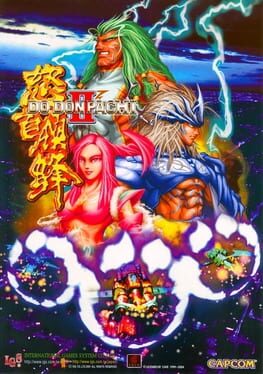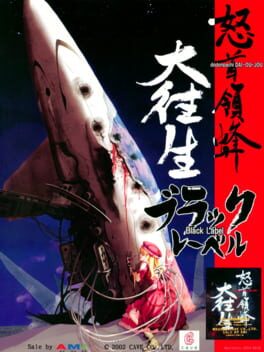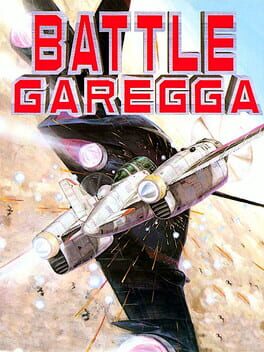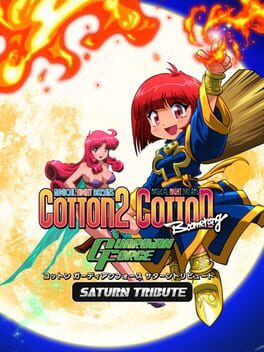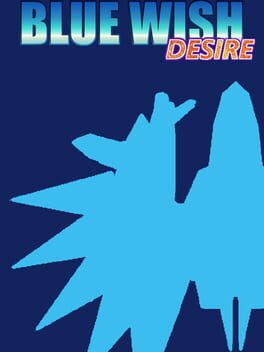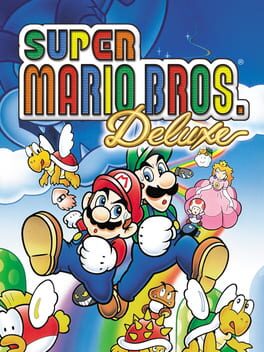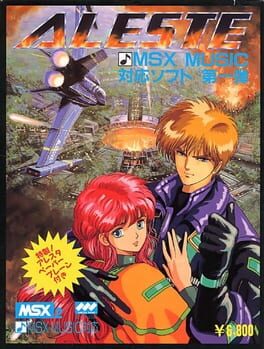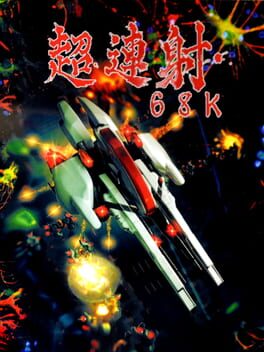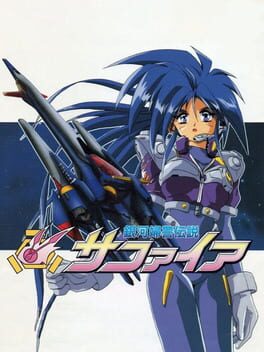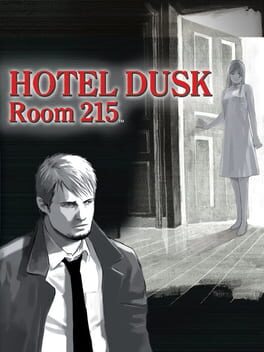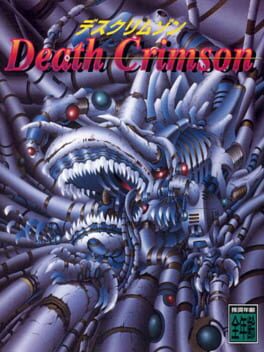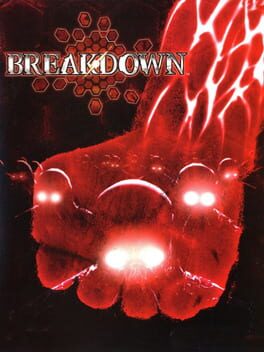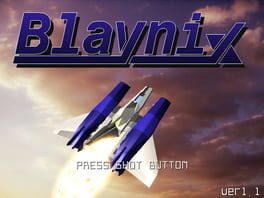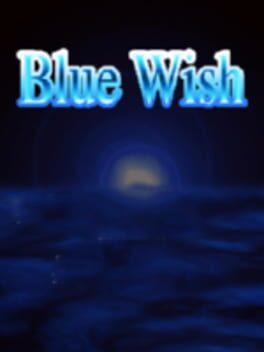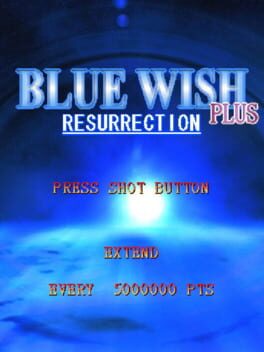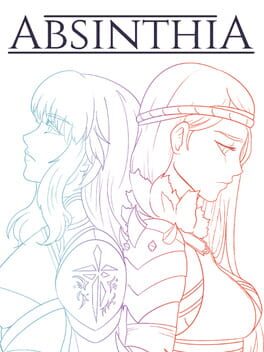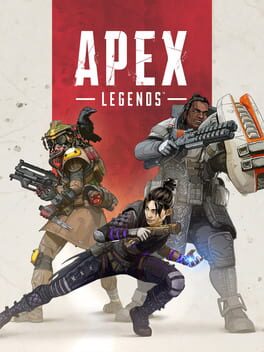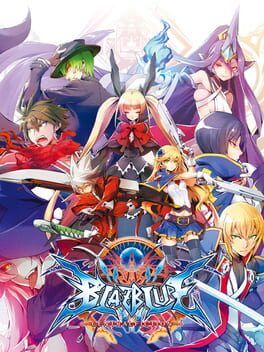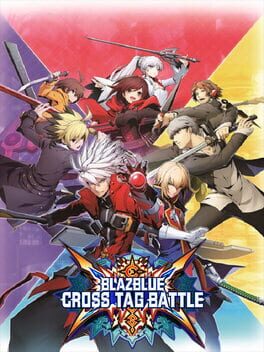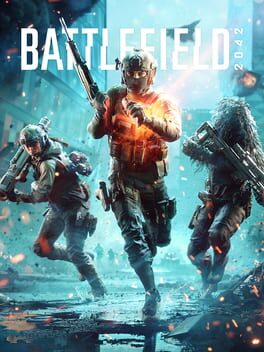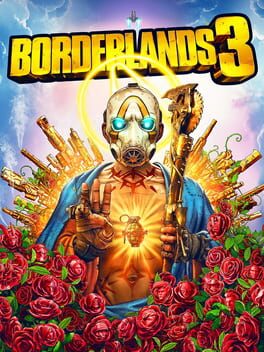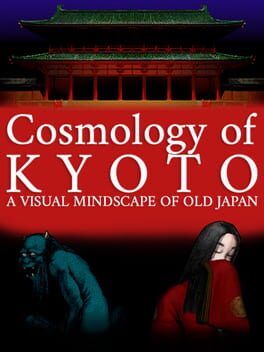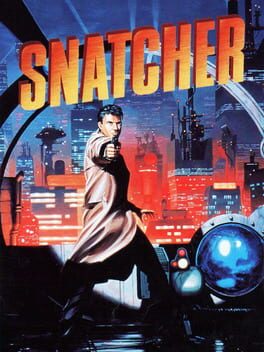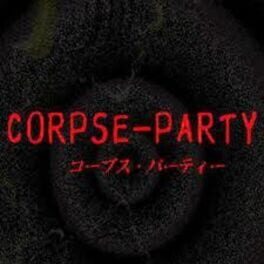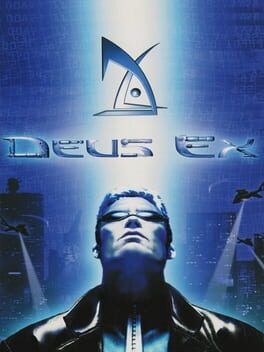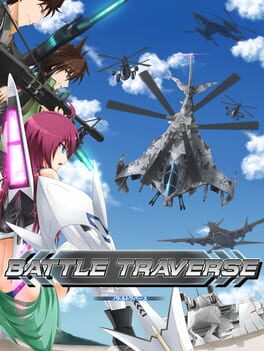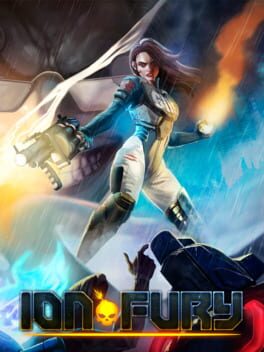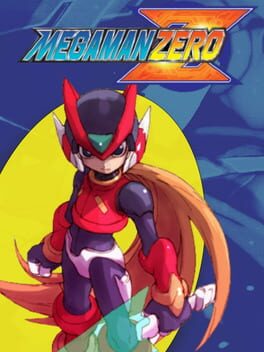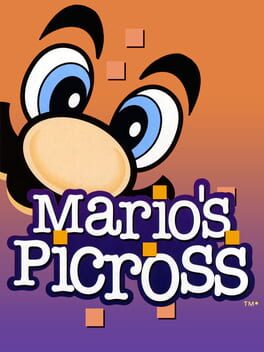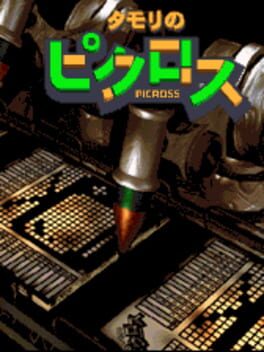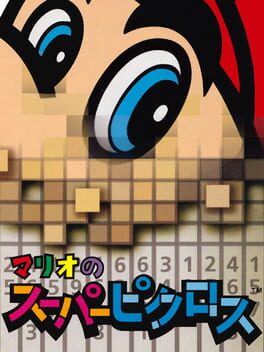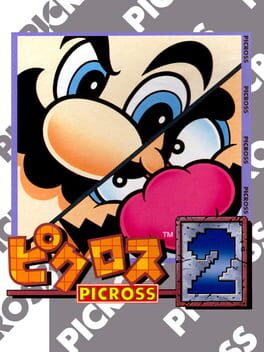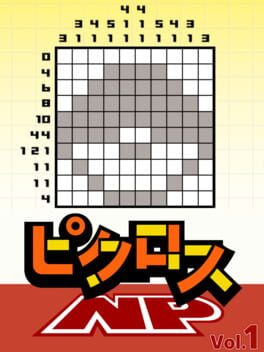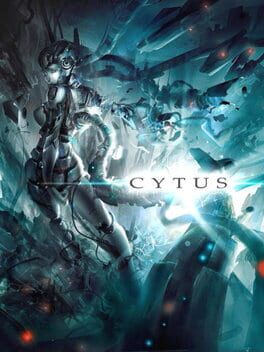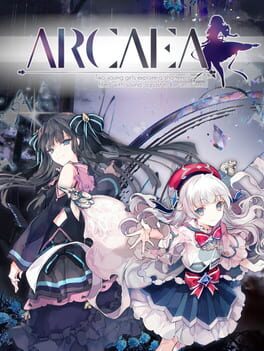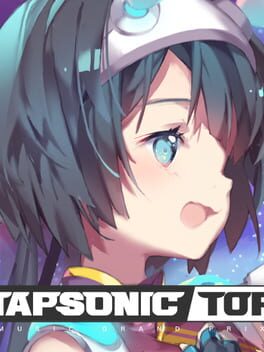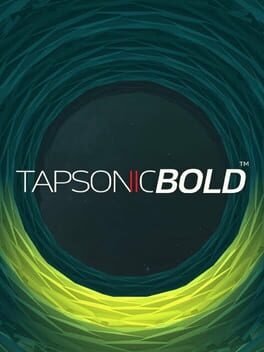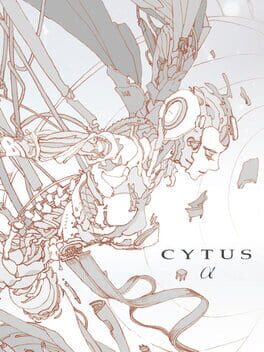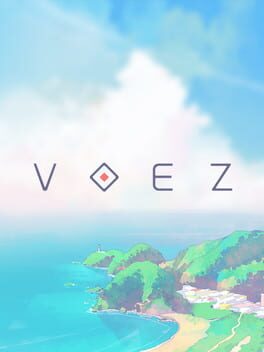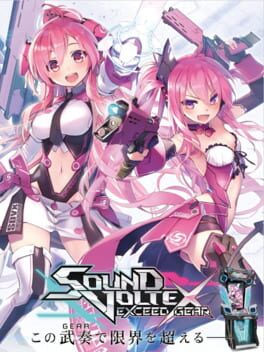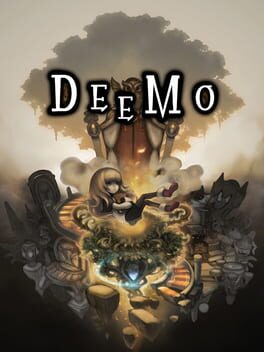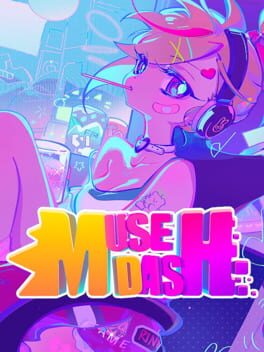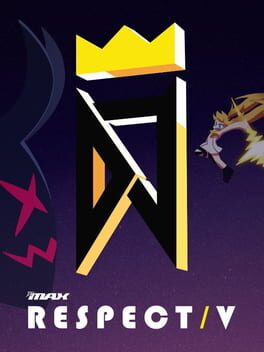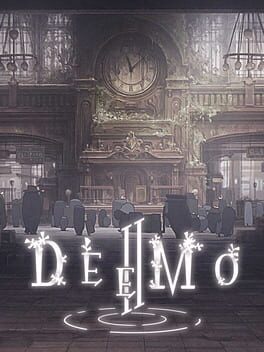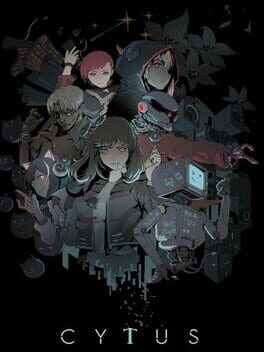RinMari
BACKER
36 reviews liked by RinMari
DoDonPachi II
2001
Bee Storm is fundamentally misunderstood, and it’s easy to get why. It’s the sequel to one of the most renowned shooting games in one of the most renowned shooting series—by CAVE, the most renowned of shooting game devs—but it was not made by CAVE, it feels nothing like a CAVE game, and in fact it only coheres with the rest of the Dodonpachi series in its ship, environment and enemy designs (as well as—vaguely—in its combo scoring mechanic). It’d be incredibly easy to play it after trying the original DDP, glimpse its sludgy, basic bullet patterns, its knockoff sprites, and its sloppier combo system, write it off as a half-baked cash-in on a moderately popular IP by Taiwanese developer IGS, and move on.
To do so, however, would be to miss a truly divine game — one whose fun is hidden a few layers below its surface, admittedly, but one that nevertheless, in my opinion at least, stands with the best and most satisfying games in the genre. That’s right. Bee Storm — the fucking meme game — is one of the better shmups of all time.
Here’s why:
1. Grazing. Bee Storm has two modes — Bomb mode, and Energy mode. The former is the mode that most clearly resembles other games in the series, and is therefore the one that players would naturally try first: you start out with a stock of bombs, collect others from destroyed enemies, and use them to help you clear the screen of bullets and do big damage. It’s shmups 101.
The reason that the game is written off so quickly by most players, though, is that Bomb mode sucks and is boring. Stock is too plentiful, and the bombs do nothing to help increase or maintain combo. The game simply is not designed around this mechanic, and I suspect it was added late in development to get DDPII more in line with its predecessors.
So where does grazing come in? Energy mode. This is the real shit. In this mode, when you get close to bullets, you charge an energy gauge that you can then release as a huge laser, not only dealing heavy damage but also (if targeting a large enemy especially) putting your combo into overdrive. Additionally, you're granted a period of about 3 seconds of invulnerability, in which—crucially—you can dive into clouds of bullets and quick-charge your gauge all over again.
I could write forever about what a beautiful and satisfying and perfect system this is, but I’ll try to keep it simple: as the game gets more difficult, it becomes more about charging your laser as quickly as possible and unleashing it, over and over. As I played this way more, and as I learned the game and its patterns and stage layouts, I could tell with striking clarity that this is the way it was meant to be played. Where once I saw these rather mundane-seeming and at times odd clusters of bullets that make little sense in normal bullet-hell dodging context, I now see them as ammunition for my laser, and in that context the game’s incredibly tight design locks into place. Stage 5 is the most concrete example, where swarms of small enemies swoop low on the screen and quickly unleash dense, hatched lines of bullets, which you can hurl yourself into during your i-frames after lasering to immediately get a second charge. You can do this over, and over, and over throughout this level in particular, and throughout the game as a whole; and it feels amazing.
2. Aura / Scoring. The aura returns from Dodonpachi – essentially a halo around the player’s ship that manifests while lasering (holding the shot button instead of rapid tapping), and that deals crazy damage when held against an enemy. The cool thing is that, in Bee Storm, it also sends your combo into the stratosphere, and thus the game really encourages you to get up close to bosses and find safe spots to hang out in, and aura the hell out of them for intensely huge, gratifying point gains.
Which leads me to say: if you haven't, play Bee Storm for score! If you’re only interested in a survival clear, Energy mode can still be really fun, but it may become a notch or two less interesting. If you gun for those 9999 end-of-level combos though, every stage is a pure adrenaline rush: a potent blend of twitch action and studious, thoughtful play to find the best points at which to aura and laser-bomb and maximize the amount of score you can wring out of enemy patterns and bosses.
Add to this that the combo system from DDP has been made much more lenient– your combo simply decreases rapidly instead of dropping to zero when not being actively added to. Stages can therefore be combo'd more organically than in the rigid DDP and DOJ, and missing one scoring strat can be made up for by nailing another later. If you really want to go advanced-mode, you could also try remaining underpowered, which allows enemies and bosses to hang around longer to be milked for score. It’s all got great flow and impressive balance if you marinate in it a while–something that the game’s unfortunately hastily garnered reputation has obscured.
3. Shot type diversity. Isn’t it rather annoying to have to commit to a single shot type (wide vs. narrow, e.g.) and ship speed for an entire playthrough, as you have to in most modern shmups? Bee Storm says fuck that, and allows you to cycle through each of its three variations during a run by pressing the Start button. I love to mostly stay in narrow formation with quick speed, darting back and forth through enemy fire for graze; but it’s fantastic to be able to resort to the screen-control-friendly wide shot when necessary. (I didn’t find much use for the second, middle ship type throughout the game, except during the true last boss fight, where, for me, it provided the perfect speed to weave through the massive number of bullets and graze for countless devastating lasers).
4. Safe spots. One common criticism leveled against the game is that it’s janky for having so many spaces to hide from enemy fire, especially during boss fights. To which I say: what’s the big deal? As someone who cleared the game with a decently high score not by watching replays but through my own repetitious playing and learning, figuring out where these spots were and exploiting them was a massive part of the game’s charm. I’ll go even further to say that I think many if not all of them exist for a specific reason, for scoring potential or to take advantage of the aforementioned laser-charges during i-frames. They don’t feel haphazard, or detrimental to the game’s balance, at all; rather, they give it an extra dimension on top of its other already-compelling systems.
5. Level diversity. Having different gameplay ‘themes’ across different stages is a relatively common thing in shmups, but you’d probably not expect to find such a pristine example of it in a game as widely mocked as Bee Storm:
Stage 1. A simple boss fight introduces the graze mechanic with highly linear, train-rail bullet patterns, and provides a cool opportunity to puzzle out how best to take it apart for maximum score (seeing as you’ll be playing it many, many times).
Stage 2. A more conventional shmup stage that introduces tight combo maintenance with a blend of popcorn enemies and larger tanks that can be aura’d. Perhaps the most DoDonPachi-style stage, with a boss that’s easily defeated but that has significant score milking potential.
Stage 3. An almost Garegga-esque stage, with wave after wave of giant ships to take out, each with multiple turrets and with popcorn enemies in tow. Here the gameplay differs greatly from stage 2, overwhelming you with bullets quickly, forcing you to bomb and providing clear and enticing opportunities to recharge. The boss is all about disassembly, piece by piece.
Stage 4. Here, ground enemies are the highlight, with tanky robots and fencing structures providing tricky barriers to your shots penetrating further upscreen. The boss features waves of ultra-fast spread patterns, the likes of which don’t really show up anywhere else in the game.
Stage 5. This is the aforementioned laser-bomb-fest, where the way that enemies are laid out (especially in the latter half of the stage) allows you to continually hurl yourself into fire while invincible, dodge for an agonizing 4-5 seconds while the bar recharges, and then unleash all over again. The boss of this stage is the best in the game, teasing you with major aura opportunities but punishing you if you get complacent.
Stage 6. A tough-as-nails, classic exercise in pure dodging. True bullet hell, with a nasty final boss to match.
Stage 7. A true last boss that you only reach if you exceed 400,000,000 points – a brilliant decision from the designers that forces you to reckon with the game’s scoring structure (and hopefully recognize the fun in it!) if you want to experience all of its content.
If it isn’t already abundantly clear, I like this game a lot. I was extremely tempted to give it a perfect 5, which would put it above the original DDP and its lauded successor DOJ in my personal ranking; but after considering it more, I think that’s a bit much. To me, DDP2 simply sits right alongside its series brethren. It sports different mechanics, sure, but it’s absolutely an equally-thrilling dopamine rush, if you’re willing to look past all of the hasty naysaying and some clunky spritework and music, and find it.
To do so, however, would be to miss a truly divine game — one whose fun is hidden a few layers below its surface, admittedly, but one that nevertheless, in my opinion at least, stands with the best and most satisfying games in the genre. That’s right. Bee Storm — the fucking meme game — is one of the better shmups of all time.
Here’s why:
1. Grazing. Bee Storm has two modes — Bomb mode, and Energy mode. The former is the mode that most clearly resembles other games in the series, and is therefore the one that players would naturally try first: you start out with a stock of bombs, collect others from destroyed enemies, and use them to help you clear the screen of bullets and do big damage. It’s shmups 101.
The reason that the game is written off so quickly by most players, though, is that Bomb mode sucks and is boring. Stock is too plentiful, and the bombs do nothing to help increase or maintain combo. The game simply is not designed around this mechanic, and I suspect it was added late in development to get DDPII more in line with its predecessors.
So where does grazing come in? Energy mode. This is the real shit. In this mode, when you get close to bullets, you charge an energy gauge that you can then release as a huge laser, not only dealing heavy damage but also (if targeting a large enemy especially) putting your combo into overdrive. Additionally, you're granted a period of about 3 seconds of invulnerability, in which—crucially—you can dive into clouds of bullets and quick-charge your gauge all over again.
I could write forever about what a beautiful and satisfying and perfect system this is, but I’ll try to keep it simple: as the game gets more difficult, it becomes more about charging your laser as quickly as possible and unleashing it, over and over. As I played this way more, and as I learned the game and its patterns and stage layouts, I could tell with striking clarity that this is the way it was meant to be played. Where once I saw these rather mundane-seeming and at times odd clusters of bullets that make little sense in normal bullet-hell dodging context, I now see them as ammunition for my laser, and in that context the game’s incredibly tight design locks into place. Stage 5 is the most concrete example, where swarms of small enemies swoop low on the screen and quickly unleash dense, hatched lines of bullets, which you can hurl yourself into during your i-frames after lasering to immediately get a second charge. You can do this over, and over, and over throughout this level in particular, and throughout the game as a whole; and it feels amazing.
2. Aura / Scoring. The aura returns from Dodonpachi – essentially a halo around the player’s ship that manifests while lasering (holding the shot button instead of rapid tapping), and that deals crazy damage when held against an enemy. The cool thing is that, in Bee Storm, it also sends your combo into the stratosphere, and thus the game really encourages you to get up close to bosses and find safe spots to hang out in, and aura the hell out of them for intensely huge, gratifying point gains.
Which leads me to say: if you haven't, play Bee Storm for score! If you’re only interested in a survival clear, Energy mode can still be really fun, but it may become a notch or two less interesting. If you gun for those 9999 end-of-level combos though, every stage is a pure adrenaline rush: a potent blend of twitch action and studious, thoughtful play to find the best points at which to aura and laser-bomb and maximize the amount of score you can wring out of enemy patterns and bosses.
Add to this that the combo system from DDP has been made much more lenient– your combo simply decreases rapidly instead of dropping to zero when not being actively added to. Stages can therefore be combo'd more organically than in the rigid DDP and DOJ, and missing one scoring strat can be made up for by nailing another later. If you really want to go advanced-mode, you could also try remaining underpowered, which allows enemies and bosses to hang around longer to be milked for score. It’s all got great flow and impressive balance if you marinate in it a while–something that the game’s unfortunately hastily garnered reputation has obscured.
3. Shot type diversity. Isn’t it rather annoying to have to commit to a single shot type (wide vs. narrow, e.g.) and ship speed for an entire playthrough, as you have to in most modern shmups? Bee Storm says fuck that, and allows you to cycle through each of its three variations during a run by pressing the Start button. I love to mostly stay in narrow formation with quick speed, darting back and forth through enemy fire for graze; but it’s fantastic to be able to resort to the screen-control-friendly wide shot when necessary. (I didn’t find much use for the second, middle ship type throughout the game, except during the true last boss fight, where, for me, it provided the perfect speed to weave through the massive number of bullets and graze for countless devastating lasers).
4. Safe spots. One common criticism leveled against the game is that it’s janky for having so many spaces to hide from enemy fire, especially during boss fights. To which I say: what’s the big deal? As someone who cleared the game with a decently high score not by watching replays but through my own repetitious playing and learning, figuring out where these spots were and exploiting them was a massive part of the game’s charm. I’ll go even further to say that I think many if not all of them exist for a specific reason, for scoring potential or to take advantage of the aforementioned laser-charges during i-frames. They don’t feel haphazard, or detrimental to the game’s balance, at all; rather, they give it an extra dimension on top of its other already-compelling systems.
5. Level diversity. Having different gameplay ‘themes’ across different stages is a relatively common thing in shmups, but you’d probably not expect to find such a pristine example of it in a game as widely mocked as Bee Storm:
Stage 1. A simple boss fight introduces the graze mechanic with highly linear, train-rail bullet patterns, and provides a cool opportunity to puzzle out how best to take it apart for maximum score (seeing as you’ll be playing it many, many times).
Stage 2. A more conventional shmup stage that introduces tight combo maintenance with a blend of popcorn enemies and larger tanks that can be aura’d. Perhaps the most DoDonPachi-style stage, with a boss that’s easily defeated but that has significant score milking potential.
Stage 3. An almost Garegga-esque stage, with wave after wave of giant ships to take out, each with multiple turrets and with popcorn enemies in tow. Here the gameplay differs greatly from stage 2, overwhelming you with bullets quickly, forcing you to bomb and providing clear and enticing opportunities to recharge. The boss is all about disassembly, piece by piece.
Stage 4. Here, ground enemies are the highlight, with tanky robots and fencing structures providing tricky barriers to your shots penetrating further upscreen. The boss features waves of ultra-fast spread patterns, the likes of which don’t really show up anywhere else in the game.
Stage 5. This is the aforementioned laser-bomb-fest, where the way that enemies are laid out (especially in the latter half of the stage) allows you to continually hurl yourself into fire while invincible, dodge for an agonizing 4-5 seconds while the bar recharges, and then unleash all over again. The boss of this stage is the best in the game, teasing you with major aura opportunities but punishing you if you get complacent.
Stage 6. A tough-as-nails, classic exercise in pure dodging. True bullet hell, with a nasty final boss to match.
Stage 7. A true last boss that you only reach if you exceed 400,000,000 points – a brilliant decision from the designers that forces you to reckon with the game’s scoring structure (and hopefully recognize the fun in it!) if you want to experience all of its content.
If it isn’t already abundantly clear, I like this game a lot. I was extremely tempted to give it a perfect 5, which would put it above the original DDP and its lauded successor DOJ in my personal ranking; but after considering it more, I think that’s a bit much. To me, DDP2 simply sits right alongside its series brethren. It sports different mechanics, sure, but it’s absolutely an equally-thrilling dopamine rush, if you’re willing to look past all of the hasty naysaying and some clunky spritework and music, and find it.
I somewhat prefer Black Label to White Label. White Label is the more difficult clear, for sure. It has the unlock criteria for the second loop, and tosses your extends when you reach it. But, Black Label is more interesting for scoring since the first loop is more difficult. It's an easier clear for beginners, and has a higher ceiling for advanced players.
Battle Garegga
1996
D4DJ Groovy Mix
2020
Damn, what a good idea! I've been waiting ages for a good, economical way to play Guardian Force and Cottom Boomerang!
I am stil waiting for a good, economical way to play Guardian Force and Cotton Boomerang.
The games here are good. Guardian Force is a rad tank-themed STG and Boomerang is easily the best cotton game (excluding the upcoming Rock n roll, which legitimately looks pretty great). The problem is that this port is horrible.
So to start, the interface is so extremely barebones. There's some very basic shit done badly like control options being seperate between the game and interface. Which is just some weird energy and makes setting up the dang controls a hassle. It's all presented really blandly and has no real sauce on it.
But the kicker here is the lag. Saturn Tribute, from what i've heard on the grape vine, is an open source saturn emulation thingy then put in a Unity wrapper for the aforementioned bad interface and presumably some other technical shit. That naturally adds a bit of lag, thats natural, and i'm not snobby enough to pretend a little of bit of it isn't a dealbreaker.
This isn't a little bit.
Preliminary tests of Guardian Force puts it at 10 frames of native input lag. That isn't just bad by STG standards (put it this way, Ketsui Deathtiny on the same console has 2 frames input lag), it's significantly worse than most AAA games and frankly, almost anything that's not a trash fire like Crystal Chronicles HD (which somehow has about 20 frames lag lmao).
Long story short, it makes the games feel like playing Red Dead Redemption 2. Whilst twitch dodging bullets. I don't like to say it but it's basically unplayable. Guardian Force's original release was already on the edge in terms of lag and this tips it way, way over the edge. And i'm not a snob on this stuff, i swear! I know for instance, an upcoming arcade game was rejected from a platform for DARING to have 4-5 frames, literally half the lag.
Guess I gotta go looking for that hacked Guardian Force Romset...
I am stil waiting for a good, economical way to play Guardian Force and Cotton Boomerang.
The games here are good. Guardian Force is a rad tank-themed STG and Boomerang is easily the best cotton game (excluding the upcoming Rock n roll, which legitimately looks pretty great). The problem is that this port is horrible.
So to start, the interface is so extremely barebones. There's some very basic shit done badly like control options being seperate between the game and interface. Which is just some weird energy and makes setting up the dang controls a hassle. It's all presented really blandly and has no real sauce on it.
But the kicker here is the lag. Saturn Tribute, from what i've heard on the grape vine, is an open source saturn emulation thingy then put in a Unity wrapper for the aforementioned bad interface and presumably some other technical shit. That naturally adds a bit of lag, thats natural, and i'm not snobby enough to pretend a little of bit of it isn't a dealbreaker.
This isn't a little bit.
Preliminary tests of Guardian Force puts it at 10 frames of native input lag. That isn't just bad by STG standards (put it this way, Ketsui Deathtiny on the same console has 2 frames input lag), it's significantly worse than most AAA games and frankly, almost anything that's not a trash fire like Crystal Chronicles HD (which somehow has about 20 frames lag lmao).
Long story short, it makes the games feel like playing Red Dead Redemption 2. Whilst twitch dodging bullets. I don't like to say it but it's basically unplayable. Guardian Force's original release was already on the edge in terms of lag and this tips it way, way over the edge. And i'm not a snob on this stuff, i swear! I know for instance, an upcoming arcade game was rejected from a platform for DARING to have 4-5 frames, literally half the lag.
Guess I gotta go looking for that hacked Guardian Force Romset...
Blue Wish Desire
2021
It’s frustrating but also kind of fascinating to see how one simple technical limitation can outweigh all the expanded content this port has going for it. Most of the aesthetic and gameplay additions are good and should easily make this the best version to experience the first Super Mario Bros. – except that screen crunch is real and truly crushing in this case. The degree to which the perspective was zoomed-in seems almost absurd in direct comparison to the NES original. Nothing more than a fraction of the screen remains in the frame, even the clouds in the sky had to be pulled down to keep them visible at all. The game somewhat tries to mitigate this drastically reduced field of vision by making some tweaks to the camera placement. For example, Mario is positioned to the left of the screen instead of in the middle. While certainly a necessary adjustment, this doesn't change that you still can see significantly less of what lies ahead of you than on the NES. You are also now able to slightly move the camera to the left when turning backwards, but only as far as the screen size from the original would have allowed for, which feels weirdly unintuitive. The rules of the NES code still apply, only that you are unable to see them now.
But the most awkward addition must be the new option to scroll the screen up and down. Not only does the ability to move the camera independently from the character completely interrupt the flow of movement in a 2D platformer like Super Mario where perception and mobility are so tightly interwoven. It also is poorly implemented, again stemming from the root cause of screen crunch. Because the frame is so tiny to begin with, every camera movement feels too fast and abrupt. At the same time, the range of possible camera movement is also too small because the camera remains tied to Mario, who has to stay visible at all times.
Consequently, the level design loses one of its most defining features: verticality. Gone is the active decision-making of choosing between multiple paths, since the consequences of each option are barely foreseeable. If anything, this illustrates just how perfectly placed the camera was on the NES. A big reason why the platforming in Super Mario Bros. feels so satisfying is because of how intentionally you are able to execute your movement. You always know where Mario is going to land when you press the jump button, but every forward movement still reveals enough of the stage to force you to stay alert and adjust to the new situation. This dynamic between proactive and reactive gameplay is almost gone in Deluxe. The experience here is more akin to playing an infinite runner, where you simply try to avoid the next obstacle in front of you. The only reliable way to make your playthrough less distorted is when you are already familiar with the levels from the original; but in that case, there is even less of a reason to play this version.
While every level is more or less negatively affected by these changes, nowhere is it more apparent than in the Cheep Cheep stages. On the NES, you can see, or at least anticipate, the complete jumping arc of the enemies and try to adjust your own movement accordingly. In Deluxe, these stages feel like you are being subjected to some kind of heavenly punishment as you are relentlessly bombarded from all sides by those goddamn fish.
__________________
More Super Mario reviews
Super Mario Bros.
Super Mario Land
More Game Boy reviews
Mole Mania
But the most awkward addition must be the new option to scroll the screen up and down. Not only does the ability to move the camera independently from the character completely interrupt the flow of movement in a 2D platformer like Super Mario where perception and mobility are so tightly interwoven. It also is poorly implemented, again stemming from the root cause of screen crunch. Because the frame is so tiny to begin with, every camera movement feels too fast and abrupt. At the same time, the range of possible camera movement is also too small because the camera remains tied to Mario, who has to stay visible at all times.
Consequently, the level design loses one of its most defining features: verticality. Gone is the active decision-making of choosing between multiple paths, since the consequences of each option are barely foreseeable. If anything, this illustrates just how perfectly placed the camera was on the NES. A big reason why the platforming in Super Mario Bros. feels so satisfying is because of how intentionally you are able to execute your movement. You always know where Mario is going to land when you press the jump button, but every forward movement still reveals enough of the stage to force you to stay alert and adjust to the new situation. This dynamic between proactive and reactive gameplay is almost gone in Deluxe. The experience here is more akin to playing an infinite runner, where you simply try to avoid the next obstacle in front of you. The only reliable way to make your playthrough less distorted is when you are already familiar with the levels from the original; but in that case, there is even less of a reason to play this version.
While every level is more or less negatively affected by these changes, nowhere is it more apparent than in the Cheep Cheep stages. On the NES, you can see, or at least anticipate, the complete jumping arc of the enemies and try to adjust your own movement accordingly. In Deluxe, these stages feel like you are being subjected to some kind of heavenly punishment as you are relentlessly bombarded from all sides by those goddamn fish.
__________________
More Super Mario reviews
Super Mario Bros.
Super Mario Land
More Game Boy reviews
Mole Mania
Aleste
1988
Yeah, I got no history with this series, and no background info to go off of, so we’ll just jump right on in this time, ALESTE! Or Power Strike if you live outside of Japan, which sounds extremely generic in comparison, so I’m gonna keep calling it Aleste. This is a game from a series that I haven’t really heard of until recently, and I am a fan of shoot-’em-ups (as you could probably guess), so I decided to check it out, and I gotta admit, this one is pretty fucking sweet. I had a pretty good time with this game, but of course, it isn’t perfect. Nevertheless, in terms of other shoot-’em-ups that I have played from around this time period so far, it has a lot going for it compared to others.
The story is about revenge mostly, which is incredibly cliche, but then again, no one cares about the story in a shoot-’em-up, the graphics are pretty good of course, having a lot of action going on at once, the music is fine, although a lot of the tracks sound very similar to each other, the control is solid of course, and the gameplay is very fun, with how much power you can obtain and dish out, but still pretty tough at the same time.
The game is your average 80s shoot-’em-up, where you control a spaceship, fire two different kinds of weapons alternatively or at once, defeat many enemies thrown and shooting at you at once, gather a wide assortment of powerups to take on threats, and defeat bosses along the way. It is all pretty much what you would expect, but I think what makes this game for me specifically are the weapons and powerups. For your main shot, you can get a bunch of P icons to not only increase the firing rate of your weapon, but also giving you a double and triple shot with the more icons you end up collecting. Let me tell you, getting all of these powerups and mowing down through hordes of enemies is incredibly satisfying, and it was really fun keeping up with all of the action.
Not to mention, there are plenty of sub-weapons that you can get to fire as well, symbolized by numbers. Depending on what number you shot and collected, you would get a new weapon such as a laser shot, a moving laser shot, a projectile that acts as a shield, and a wide shot, which may be my personal favorite of the bunch. Not only does this selection of weapons provide a lot of different weapons to try out, but offers a lot of strategy and fast reactions similar to Gradius, where you gotta think fast about what weapon you should grab and use quickly before it is too late. Although, I will admit, not all of the weapons are really all that great, and frankly, after trying them all out, you’ll probably only use one or two of them whenever you get the chance.
With all that being said, this all comes at the cost of the game’s difficulty. Much like other shooters at the time, this game is FUCKING HARD, as there are plenty of enemies thrown at you all over the place, with there being very little room for error. Again, having the powerups to use does help make things more manageable, but things still tend to be pretty tough. Not to mention, if you die, you lose all of your upgrades, which is to be expected from a game like this, but considering how long and circumstantial it can be to get these powerups back, it can feel absolutely devastating when you die in terms of difficulty and versatility, meaning that dying is almost not an option if you wanna reach the end.
Aside from the difficulty, some other problems with the game would be that be a lot of the bosses feel very similar, usually being just a formation with the same amount of weak points, or a tiny ship that flashes the same colors before they die, and it does get repetitive after a bit. And speaking of which the game itself is also pretty repetitive, given how many stages you go through that contain basically the same setup with the same enemies flying at you constantly. In addition, it feels like the stages go on a lot longer then they need to. Sure, it enough to where you won’t beat the game that quickly, which is good, but again, given the amount of repetition in the game, it can feel like stages are dragging on after a while.
Overall, despite the brutal difficulty, unforgiving punishment, and the lack of variety with regular gameplay, I still had a really good time with Aleste, and I am glad that I did check it out, making wanna check out what the other games in the series are like. I just hope that they don’t kick my ass as much as this one does.
Game #222
The story is about revenge mostly, which is incredibly cliche, but then again, no one cares about the story in a shoot-’em-up, the graphics are pretty good of course, having a lot of action going on at once, the music is fine, although a lot of the tracks sound very similar to each other, the control is solid of course, and the gameplay is very fun, with how much power you can obtain and dish out, but still pretty tough at the same time.
The game is your average 80s shoot-’em-up, where you control a spaceship, fire two different kinds of weapons alternatively or at once, defeat many enemies thrown and shooting at you at once, gather a wide assortment of powerups to take on threats, and defeat bosses along the way. It is all pretty much what you would expect, but I think what makes this game for me specifically are the weapons and powerups. For your main shot, you can get a bunch of P icons to not only increase the firing rate of your weapon, but also giving you a double and triple shot with the more icons you end up collecting. Let me tell you, getting all of these powerups and mowing down through hordes of enemies is incredibly satisfying, and it was really fun keeping up with all of the action.
Not to mention, there are plenty of sub-weapons that you can get to fire as well, symbolized by numbers. Depending on what number you shot and collected, you would get a new weapon such as a laser shot, a moving laser shot, a projectile that acts as a shield, and a wide shot, which may be my personal favorite of the bunch. Not only does this selection of weapons provide a lot of different weapons to try out, but offers a lot of strategy and fast reactions similar to Gradius, where you gotta think fast about what weapon you should grab and use quickly before it is too late. Although, I will admit, not all of the weapons are really all that great, and frankly, after trying them all out, you’ll probably only use one or two of them whenever you get the chance.
With all that being said, this all comes at the cost of the game’s difficulty. Much like other shooters at the time, this game is FUCKING HARD, as there are plenty of enemies thrown at you all over the place, with there being very little room for error. Again, having the powerups to use does help make things more manageable, but things still tend to be pretty tough. Not to mention, if you die, you lose all of your upgrades, which is to be expected from a game like this, but considering how long and circumstantial it can be to get these powerups back, it can feel absolutely devastating when you die in terms of difficulty and versatility, meaning that dying is almost not an option if you wanna reach the end.
Aside from the difficulty, some other problems with the game would be that be a lot of the bosses feel very similar, usually being just a formation with the same amount of weak points, or a tiny ship that flashes the same colors before they die, and it does get repetitive after a bit. And speaking of which the game itself is also pretty repetitive, given how many stages you go through that contain basically the same setup with the same enemies flying at you constantly. In addition, it feels like the stages go on a lot longer then they need to. Sure, it enough to where you won’t beat the game that quickly, which is good, but again, given the amount of repetition in the game, it can feel like stages are dragging on after a while.
Overall, despite the brutal difficulty, unforgiving punishment, and the lack of variety with regular gameplay, I still had a really good time with Aleste, and I am glad that I did check it out, making wanna check out what the other games in the series are like. I just hope that they don’t kick my ass as much as this one does.
Game #222
Cho Ren Sha 68K
1995
Justice of Galaxy started playing.
The music had a moment- a dramatic sting. In perfect sync with this, the game introduces an enemy type you've never seen before in droves.
All 6 of them begin moving and shooting at the precise second the track kicks in. The rest of the stage never lets up after this.
I haven't beaten this game. I don't know if I'm going to be able to anytime soon. But things like that are what earns 10/10s from me; the understanding that the visuals and audio can be just as important to a game as its mechanics, and just as impactful if used correctly. The impression was definitely made, and now I'm committed to seeing it through.
This game wipes the floor with my ass and I keep coming back just because of that. I don't even care if the background is the same for the whole thing. It's good. And free!
The music had a moment- a dramatic sting. In perfect sync with this, the game introduces an enemy type you've never seen before in droves.
All 6 of them begin moving and shooting at the precise second the track kicks in. The rest of the stage never lets up after this.
I haven't beaten this game. I don't know if I'm going to be able to anytime soon. But things like that are what earns 10/10s from me; the understanding that the visuals and audio can be just as important to a game as its mechanics, and just as impactful if used correctly. The impression was definitely made, and now I'm committed to seeing it through.
This game wipes the floor with my ass and I keep coming back just because of that. I don't even care if the background is the same for the whole thing. It's good. And free!
10 lists liked by RinMari
by tomzacz |
50 Games
by MiyaKa |
67 Games
by andrearitsu |
44 Games
by andrearitsu |
43 Games
by tomzacz |
40 Games
by YumeGabbi |
17 Games
by YumeGabbi |
16 Games
by YumeGabbi |
25 Games
